
In the serene embrace of Olivia Turner’s lush garden, I found myself immersed in a world where nature meets geometry. Olivia, a distinguished landscape design expert, exudes a passion for creating gardens that are both functional and aesthetically pleasing. Her approach, which emphasises strong lines and geometric shapes, promises to transform any outdoor space into a structured haven of beauty and flow.
Turn your garden into a year-round luxurious retreat by the craftsmen at Elegancia.homes.
As we sat amidst her meticulously curated garden, Olivia shared her insights on how structured lines and geometric shapes can redefine garden spaces. Her wisdom was not just theoretical; it was evident in the very layout of the garden surrounding us.
“Strong lines and geometric shapes aren’t just about aesthetics,” Olivia began, gesturing towards a neatly paved path that cut across the garden. “They create a sense of order and guide the flow of movement. It’s about creating a narrative in the garden, one that invites people to explore and linger.”
Olivia’s garden was a testament to her philosophy. Linear paths stretched across the lawn, their symmetry inviting the eye to follow their course. The paths were not merely functional; they were a design element that added depth and dimension. “When you use linear paths,” Olivia explained, “you guide visitors through the garden, allowing them to experience it in a curated way. It’s like reading a book with chapters that unfold as you walk.”
Her use of geometric shapes extended beyond the pathways. Symmetrical flower beds bordered the paths, their angular edges softened by the vibrant blooms within. “Symmetry brings balance,” Olivia noted. “It provides a counterpoint to the wildness of nature, allowing both elements to shine.”
Olivia’s passion for geometric design was also evident in her choice of plantings. Clipped boxwoods formed neat hedges, their precise lines contrasting beautifully with the softer, more organic shapes of the flowering plants they framed. “Geometry doesn’t mean rigidity,” she clarified. “It’s about creating a framework within which nature can express itself.”
As we strolled through the garden, Olivia pointed out a seating area nestled within a circular patio. Here, the use of geometry was more subtle but no less impactful. “Circular shapes create a sense of intimacy,” Olivia explained. “They draw people in, making the space feel inviting and complete.”
The seating area was a masterclass in blending form and function. Angular garden chairs, chosen for their contemporary design, echoed the geometric theme while providing comfortable spots from which to enjoy the garden. “Outdoor furniture should complement the design,” Olivia emphasised. “It should enhance the space, not compete with it.”
Olivia’s garden was not just a visual feast; it was a lesson in the art of sustainable design. “Sustainability is at the heart of everything I do,” she said. “From the materials I choose to the plants I select, everything is considered for its environmental impact.”
She pointed to the reclaimed wood used in the garden’s decking, a testament to her commitment to the “Three Rs”: Reuse, Restore, and Rehome. “Using reclaimed materials not only reduces waste but also adds character to the garden,” she noted.
Olivia’s dedication to sustainability extended to her choice of plants. She favoured native species, which thrived with minimal intervention and supported local wildlife. “Choosing the right plants is crucial,” she advised. “They should be suited to the climate and soil, ensuring they require less water and care.”
Our conversation turned to the role of a landscape designer in creating such spaces. “A landscape designer brings a wealth of knowledge,” Olivia explained. “From plant selection to soil types and site conditions, we ensure that every element of the garden works together harmoniously.”
Her advice to those considering a garden redesign was simple: invest in professional insight. “A designer can help you avoid costly mistakes,” she said. “We work with the space, not against it, creating a garden that is both beautiful and functional.”
As our interview drew to a close, I asked Olivia about the future of garden design. Her response was both hopeful and inspiring. “Garden design is evolving,” she said. “There’s a growing appreciation for spaces that are not only beautiful but also sustainable and resilient. It’s an exciting time to be in this field.”
Leaving Olivia’s garden, I felt enriched by her insights. Her passion for blending strong lines and geometric shapes with sustainable practices offered a fresh perspective on garden design. For anyone seeking to transform their outdoor space, her advice is clear: embrace structure, honour nature, and let the garden tell its story.
Elaine Cooper


Be the first to comment